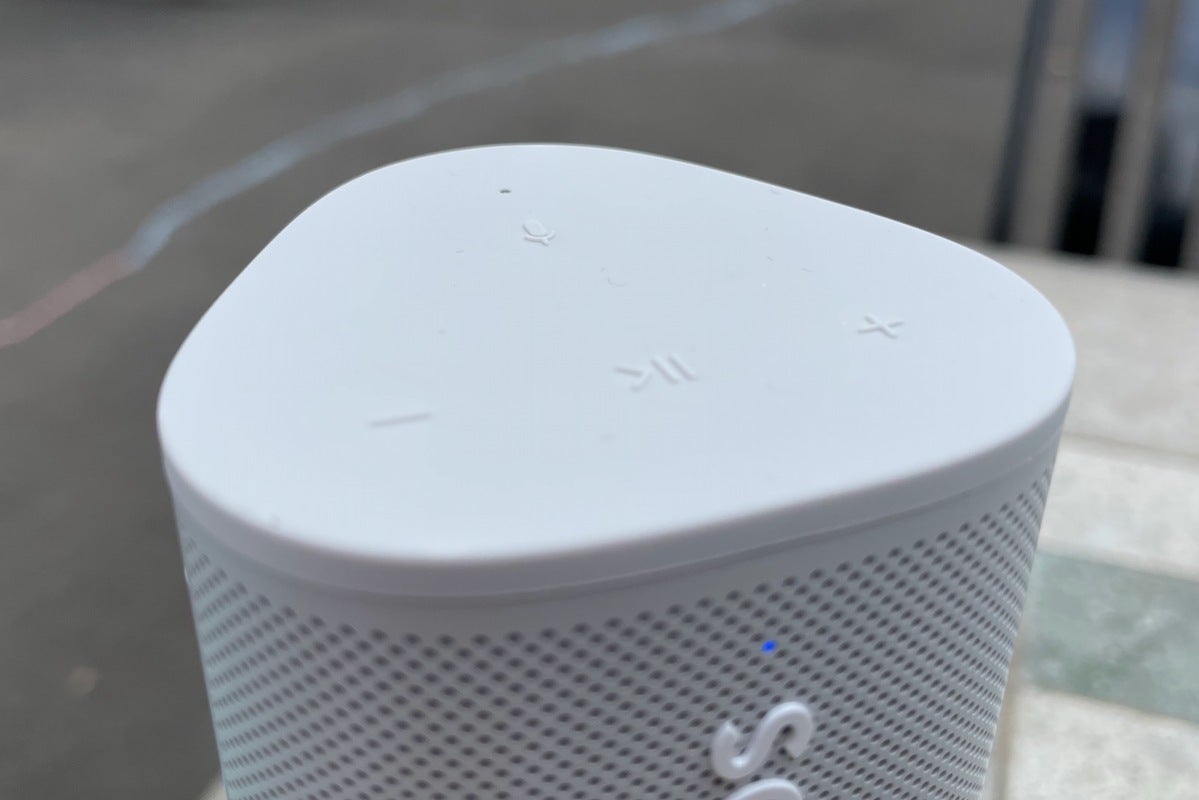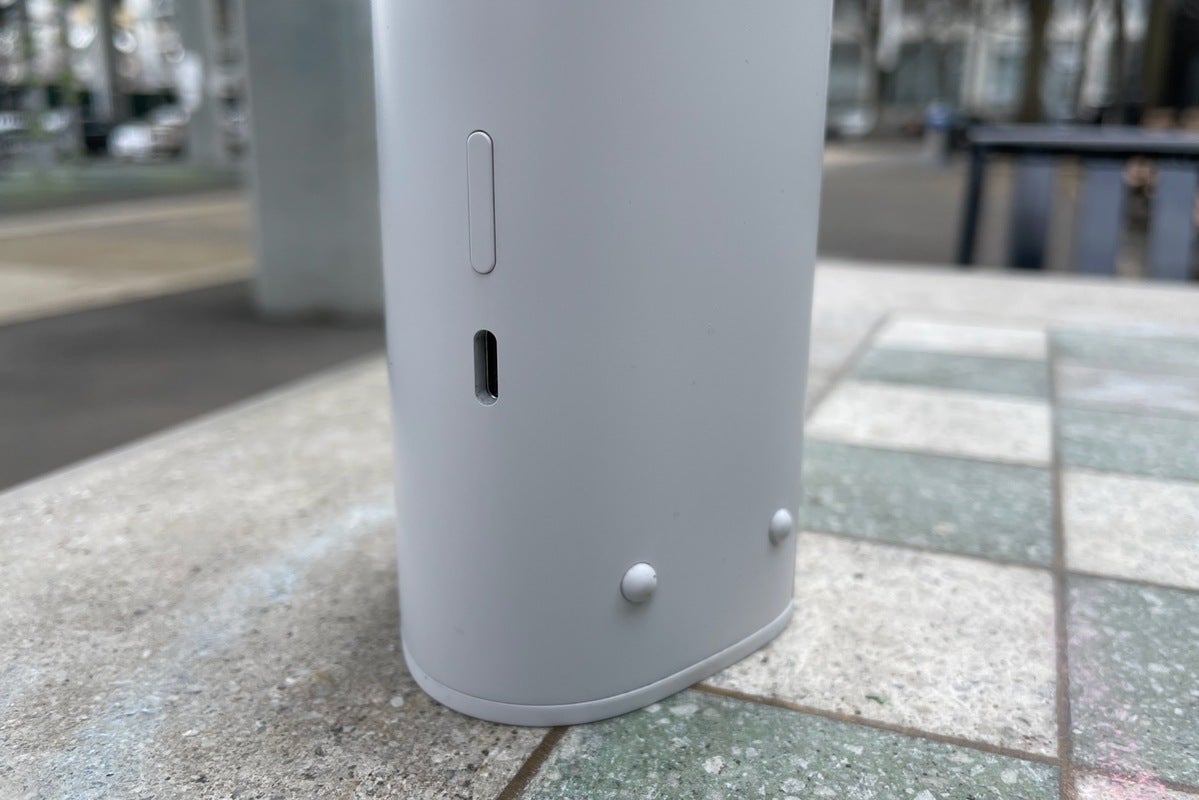Small, lightweight, packed with great networking features plus your choice of Alexa or Google Assistant, the sweet-sounding Sonos Roam just became the portable smart speaker to beat.

Ben Patterson/IDG
Today’s Best Tech Deals
Picked by TechHive’s Editors
Top Deals On Great Products
Picked by Techconnect’s Editors
Show More
It’s become de rigueur to call the Sonos Move a luggable speaker rather than a portable one. Tipping the scales at six pounds, the Move delivers big, bold, yet refined sound that you can take to the backyard, the park, or even the beach, but it’s a hefty, bulky smart speaker better suited to the trunk of a car than the confines of a backpack.
With the compact, lightweight Roam, Sonos is aiming for a speaker that you’d cheerfully toss into a purse or a knapsack, but without compromising—well, not too much—on audio quality. Has Sonos delivered on its promise? Let’s give it a listen.
This review is part of TechHive’s coverage of the best smart speakers, where you’ll find reviews of the competition’s offerings, plus a buyer’s guide to the features you should consider when shopping for this type of product.
Design
Measuring 6.1 x 2.4 x 2.4 inches (HxWxD) and weighing a hair less than a pound, the $169 Sonos Roam is about the same size as a 500ml water bottle, making it Sonos’s smallest speaker by far. Available in either shadow black or lunar white flavors (I tested the lunar white version), the Roam was a pleasure to tote around, fitting neatly in my hand and feeling impressively light but not insubstantial. On a recent jaunt to the park, I could barely feel the Roam in my shoulder bag, while the same couldn’t be said of the luggable five-pound Sonos Move.
 Ben Patterson/IDG
Ben Patterson/IDGCapable of standing vertically as well as resting on its side, the Sonos Roam makes for a great cook’s companion.
Thanks to its rounded triangular design, the Roam can sit in a variety of positions during playback. The speaker has four rubberized feet along one side for when it’s sitting horizontally on a smooth tabletop, but it can also remain stable laying on the other side—and since “Sonos” is a palindrome, the logo never looks upside down. Another option is to place it vertically on its (also rubberized) end cap, which came in handy when using the Roam on a crowded backyard table.
Not only is the Roam versatile in terms of how you can place it, but it’s also tough. Equipped with an IP67-certified shell, the Roam has been designed to withstand being dunked in up to a meter of water for 30 minutes, and it’s also completely resistant to dust ingress. Sonos encouraged me to put the Roam’s ruggedized design to the test, so I went ahead and held it under a faucet and then submerged it in a bowl of water, while the speaker was still playing. As promised, the Roam didn’t skip a beat, although it took a little time for its speaker grille to completely dry.
Buttons and interfaces
While one of the Roam’s rubberized end caps serves as a base, the other holds four buttons: two for volume control, a play/pause button, and a mic mute button. Unlike Sonos’s other speakers, the Roam’s buttons are both tactile and clickable rather than flat and touch-enabled. Sonos said it went the tactile way to prevent accidental button presses when (for instance) the Roam is floating around in a backpack, or in case you decide to toss the Roam on a picnic blanket.
 Ben Patterson/IDG
Ben Patterson/IDGUnlike Sonos’s previous speakers, the buttons on the Roam are both tactile and clickable.
The Roam’s play/pause button can perform a variety of functions. For example, you can double-press the button to skip a track, or triple-press it to go back to the previous tracks. Long-pressing the play/pause button also lets you group the Roam with other Sonos speakers, as well as trigger the new Sound Swap feature, which I’ll cover a little later.
On the back of the Roam are a USB-C charging port (you can also charge the Roam via Qi wireless charging, as I’ll also discuss later) and a power button. Pressing the button once puts the Roam in a power-save mode that helps the battery to keep its charge for up to 10 days, or you can press and hold the button for five seconds to turn the speaker off completely. The Roam will also go into its low-power “sleep” mode after about a half hour or so if it’s not playing music while running on battery power.
 Ben Patterson/IDG
Ben Patterson/IDGThe Sonos Roam’s power button sits in back, just above a USB-C charging port. You can also see two of the Roam’s four rubberized feet.
In addition to the buttons, there are three LEDs on the Roam: one that tells you when the microphone is active, a second that glows either white or blue depending on whether the Roam is connected to Wi-Fi or Bluetooth, and an orange light that indicates that the Roam is charging or running low on juice.
Setup
Connecting a Sonos speaker to a home wireless network has always been a snap, and the Roam is no different. If the Roam is your first Sonos speaker, you’ll first need to install the Sonos S2 mobile app for iOS or Android (I used the iOS version), then create a Sonos account and enter your Wi-Fi credentials. If you already own a Sonos speaker, all you’ll need to do is tap the Add Product button in the Sonos app.
Setting up the Roam in my Brooklyn apartment, the Sonos app discovered the Roam almost instantly. It then prompted me to tap my iPhone on the side of the speaker between its four feet, thus allowing the devices to identify each other using their respective NFC (near-field communication) chips. It took a couple of tries for the NFC handshake to work, but once it did, the Sonos app connected the Roam to my wireless network and automatically downloaded a firmware update. Once that was done, the Roam was ready to go, with the whole setup process taking less than five minutes.
Specifications
The Sonos Roam comes with a pair of drivers: a 16mm tweeter and a mid-woofer with an oval (aka “racetrack”) design. When I asked for the exact size of the woofer, I was told that it’s “not measured by a standard dimension,” but based on a blow-up view of the Roam on the Sonos website, the driver appears to fit snugly in the top half of the speaker.
Both of the drivers get their own Class H amplifiers, a departure from the Class D amps that power Sonos’s other speakers (and most powered consumer speakers). Sonos said it opted for the Class H amps because they “don’t sacrifice power for size.” Sounds good, but we’ll judge whether the new amplifiers translate into “no-sacrifices” audio later in the review.
The Roam supports both Wi-Fi 5 (802.11ac) and Bluetooth 5.0, making the Roam only the second Bluetooth-enabled speaker from Sonos (following 2019’s Move, of course). The Roam supports the standard SBC and AAC codecs but not the high-resolution aptX HD or LDAC codecs from Qualcomm and Sony respectively.
When connected to Wi-Fi, the speaker (along with Sonos’s other, newer networked speakers) supports up to 24-bit/48kHz high-resolution audio. For now, however, the only way to hear 24-bit audio via Sonos’s multiroom audio platform is by playing local FLAC or ALAC audio files or (as I’ll detail in a bit) streaming high-resolution music from Qobuz, provided you’re a Qobuz Premier subscriber.
As with Sonos’ other speakers, you can cast music to the Roam via Apple’s AirPlay 2 protocol, and it will also appear as a HomeKit device in the Apple Home app. Sonos has yet to play nice with Chromecast.
Features and functionality
Thanks to the Sonos wireless platform, you can group the Roam with other Sonos speakers on your home network. (You can also group Sonos speakers with AirPlay 2-compatible speakers, if you wish.) One method for grouping Sonos speakers is via the Sonos app; you just tap the System tab (on iOS), tap the grouping icon on an available speaker, then select the speakers you want to group. You can also create standing groups, like “Upstairs,” “Kitchen,” “Living Room,” or “Everywhere,” allowing you to play tunes in some or all of your rooms. The sleek, intuitive Sonos app makes the whole speaker-grouping process easy.
If you’d rather not pull out your phone, you could also group the Roam to a Sonos speaker group by pressing and holding the play/pause button, a process that’s similar to other Sonos speakers. Adding a twist, the Roam’s new Sound Swap feature lets you “swap” music with the nearest Sonos speaker in your home if you keep holding the play/pause button, making for a clever way of (for example) grabbing music from a Sonos speaker group and taking it into the backyard, or swapping the tunes back inside once you return.
 Ben Patterson/IDG
Ben Patterson/IDGThe Sonos Roam is a fraction the size of the six-pound Move, but it doesn’t sacrifice Sonos’s signature grouping or networking features in the process.
The Roam’s grouping and Sound Swap features get more complicated once you throw its Wi-Fi and Bluetooth capabilities into the mix. If you’re coming home with the Roam connected to your phone via Bluetooth, you can seamlessly group the Roam with your other Sonos speakers while still playing Bluetooth tunes (the Roam automatically reconnects to Wi-Fi once it’s back in range). That said, Sound Swap won’t work across Bluetooth and Wi-Fi (or AirPlay 2, for that matter), so you’ll need to stop Bluetooth streaming on the Roam and queue up some tunes via Wi-Fi before you start swapping music back and forth.
Much more simple is Auto Trueplay, a feature that automatically tunes the Roam’s audio depending on the surrounding acoustics. Initially, Sonos’ Trueplay feature required help from an iPhone’s integrated microphone to detect the acoustics in a room, but with 2019’s Sonos Move, Trueplay earned its “Auto” designation by using its built-in mics to perform those measurements, all without any prompting from the user. With this year’s Roam, Auto Trueplay drops the Wi-Fi-only requirement it had on the Move, meaning the feature now works over Bluetooth as well as Wi-Fi. (The Move’s Auto Trueplay feature will soon work over Bluetooth as well.) We’ll talk more about Auto Trueplay in the performance section.
Music streaming services and local music support
Sonos supports more than 100 streaming music services, ranging from Apple Music and Amazon Music to Spotify and Tidal, with Audible, Deezer, Pandora, TuneIn, iHeartRadio, and YouTube music also in the mix.
As I already mentioned, Qobuz is (for now) the only streaming service that allows for 24-bit audio streaming via Sonos. Amazon Music (which has a high-resolution “HD” tier) and Tidal streaming is restricted to 16-bit CD-quality tunes, while Deezer’s 16-bit audio streams (the service lacks a high-res tier) are supported.
Besides music streaming services, the Sonos app lets you connect with local media servers and UPnP servers, or you can connect to a networked folder on a PC or NAS box that contains music files. Plex users can also stream their music libraries to the Sonos Roam and other Sonos speakers, provided they’ve enabled remote internet access on their Plex servers. If you have 24-bit audio files on your local network, you can stream them to Sonos speakers, including the Roam, with the caveat that Sonos’s wireless platform only supports a maximum sampling rate of 48kHz.
Voice assistants
Sonos has been offering the choice of onboard Alexa or Google Assistant on its speakers for years now, and the Roam follows suit. From the Sonos app, you simply pick which assistant you want installed on the speaker, and the Roam does the rest, pausing only so you can enter either your Amazon or Google credentials.
Once Alexa or Google Assistant is installed, the Roam essentially becomes a smart speaker, performing pretty much any task that an Amazon Echo or Google Nest speaker can. You can ask about the weather, get your schedule, set alarms and timers, and control your smart home devices. Even better, you can use voice commands to play music—for example, you could say “Alexa, play Taylor Swift on Spotify”—as well as pause or resume tunes, skip tracks, and adjust the volume.
Click here to read about the Sonos Roam’s battery life and audio performance
Small, lightweight, packed with great networking features plus your choice of Alexa or Google Assistant, the sweet-sounding Sonos Roam just became the portable smart speaker to beat.
Pros
- Exceptional sound for its size
- Auto Trueplay now works over Bluetooth
- Sound Swap feature lets you “swap” music with other Sonos speakers
- Small and light, with a waterproof design
Cons
- Slow wireless charging (at least with third-party chargers)
- Sound Swap doesn’t work across Wi-Fi, Bluetooth, and AirPlay 2 modes

